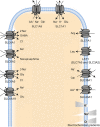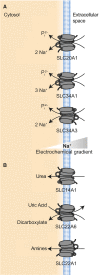A guide to plasma membrane solute carrier proteins
- PMID: 32810346
- PMCID: PMC8246967
- DOI: 10.1111/febs.15531
A guide to plasma membrane solute carrier proteins
Abstract
This review aims to serve as an introduction to the solute carrier proteins (SLC) superfamily of transporter proteins and their roles in human cells. The SLC superfamily currently includes 458 transport proteins in 65 families that carry a wide variety of substances across cellular membranes. While members of this superfamily are found throughout cellular organelles, this review focuses on transporters expressed at the plasma membrane. At the cell surface, SLC proteins may be viewed as gatekeepers of the cellular milieu, dynamically responding to different metabolic states. With altered metabolism being one of the hallmarks of cancer, we also briefly review the roles that surface SLC proteins play in the development and progression of cancer through their influence on regulating metabolism and environmental conditions.
Keywords: amino acids; cancer; cell surface; cellular metabolism; cellular transport; glucose; pH; physiology; plasma membrane; solute carrier transporter.
© 2020 The CeMM Research Center for Molecular Medicine of the Austrian Academy of Sciences. The FEBS Journal published by John Wiley & Sons Ltd on behalf of Federation of European Biochemical Societies.
Conflict of interest statement
The authors declare a conflict of interest. Ariel Bensimon and Giulio Superti‐Furga have filed patents on SLC pharmacology that will be the object of a commercialization effort in the future.
Figures








References
-
- Okada Y (2004) Ion channels and transporters involved in cell volume regulation and sensor mechanisms. Cell Biochem Biophys 41, 233–258. - PubMed
-
- Stein WD & Litman T. Cambridge, MA: (2014) Channels, Carriers, and Pumps: An Introduction to Membrane Transport, 2nd edn. Cambridge, MA.
-
- Wang W, Gallo L, Jadhav A, Hawkins R & Parker CG (2019) The druggability of solute carriers. J Med Chem 63, 3834–3867. - PubMed
Publication types
MeSH terms
Substances
LinkOut - more resources
Full Text Sources
Medical

